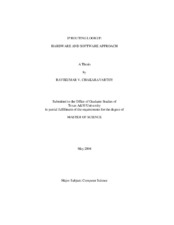| dc.contributor.advisor | Liu, Jyh-Charn | |
| dc.contributor.advisor | Mahapatra, Rabi | |
| dc.creator | Chakaravarthy, Ravikumar V. | |
| dc.date.accessioned | 2005-08-29T14:42:19Z | |
| dc.date.available | 2005-08-29T14:42:19Z | |
| dc.date.created | 2003-05 | |
| dc.date.issued | 2005-08-29 | |
| dc.identifier.uri | https://hdl.handle.net/1969.1/2459 | |
| dc.description.abstract | The work presented in this thesis is motivated by the dual goal of developing a scalable and efficient approach for IP lookup using both hardware and software approach. The work involved designing algorithms and techniques to increase the capacity and flexibility of the Internet. The Internet is comprised of routers that forward the Internet packets to the destination address and the physical links that transfer data from one router to another. The optical technologies have improved significantly over the years and hence the data link capacities have increased. However, the packet forwarding rates at the router have failed to keep up with the link capacities.
Every router performs a packet-forwarding decision on the incoming packet to determine the packet??s next-hop router. This is achieved by looking up the destination address of the incoming packet in the forwarding table. Besides increased inter-packet arrival rates, the increasing routing table sizes and complexity of forwarding algorithms have made routers a bottleneck in the packet transmission across the Internet.
A number of solutions have been proposed that have addressed this problem. The solutions have been categorized into hardware and software solutions. Various lookup algorithms have been proposed to tackle this problem using software approaches. These approaches have proved more scalable and practicable. However, they don??t seem to be able to catch up with the link rates. The first part of my thesis discusses one such software solution for routing lookup.
The hardware approaches today have been able to match up with the link speeds. However, these solutions are unable to keep up with the increasing number of routing table entries and the power consumed. The second part of my thesis describes a hardware-based solution that provides a bound on the power consumption and reduces the number of entries required to be stored in the routing table. | en |
| dc.format.extent | 402260 bytes | en |
| dc.format.medium | electronic | en |
| dc.format.mimetype | application/pdf | |
| dc.language.iso | en_US | |
| dc.publisher | Texas A&M University | |
| dc.subject | Routing IP lookup TCAM prefixes | en |
| dc.title | IP routing lookup: hardware and software approach | en |
| dc.type | Book | en |
| dc.type | Thesis | en |
| thesis.degree.department | Computer Science | en |
| thesis.degree.discipline | Computer Science | en |
| thesis.degree.grantor | Texas A&M University | en |
| thesis.degree.name | Master of Science | en |
| thesis.degree.level | Masters | en |
| dc.contributor.committeeMember | Reddy, A. L. Narasimha | |
| dc.type.genre | Electronic Thesis | en |
| dc.type.material | text | en |
| dc.format.digitalOrigin | born digital | en |


